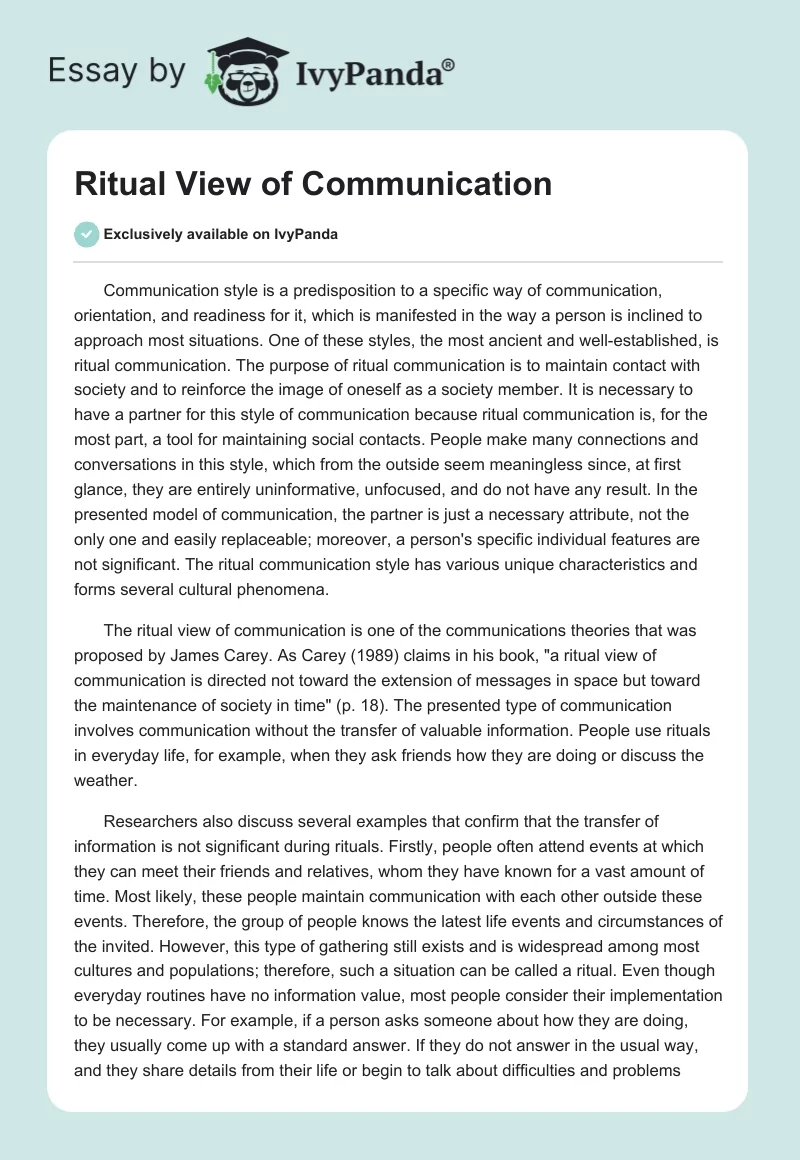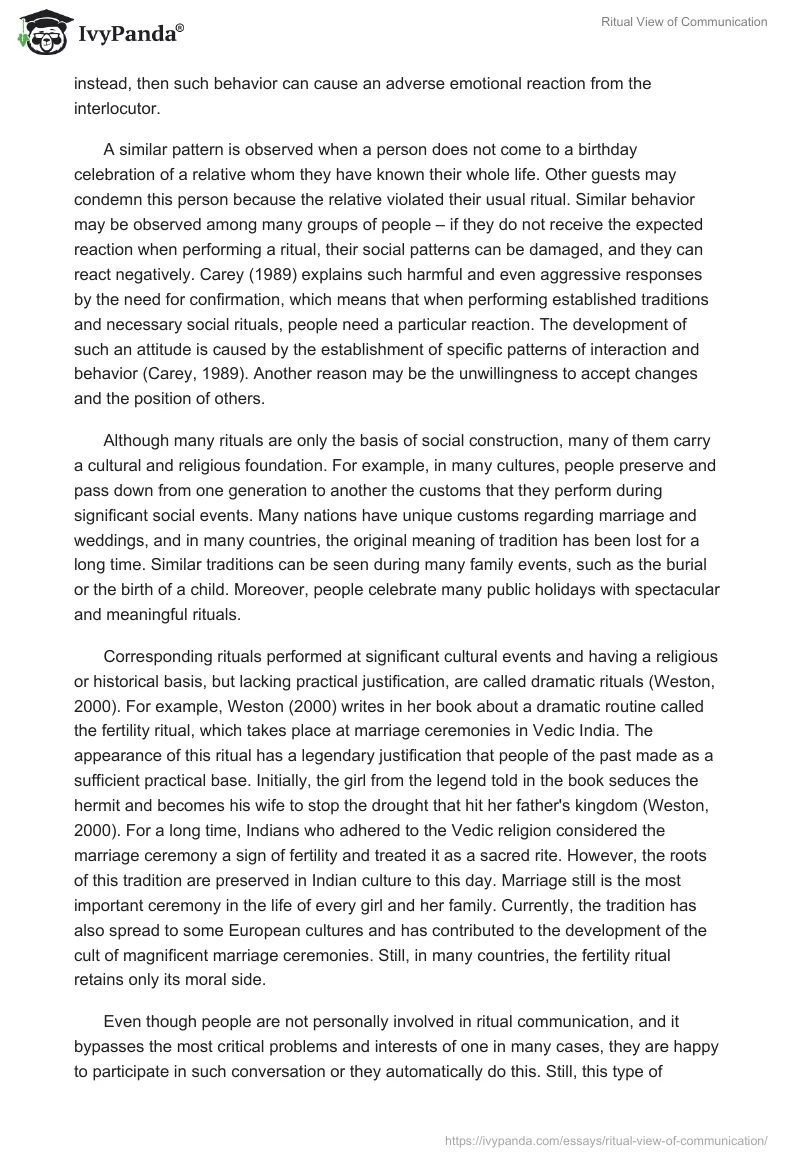Communication style is a predisposition to a specific way of communication, orientation, and readiness for it, which is manifested in the way a person is inclined to approach most situations. One of these styles, the most ancient and well-established, is ritual communication. The purpose of ritual communication is to maintain contact with society and to reinforce the image of oneself as a society member. It is necessary to have a partner for this style of communication because ritual communication is, for the most part, a tool for maintaining social contacts. People make many connections and conversations in this style, which from the outside seem meaningless since, at first glance, they are entirely uninformative, unfocused, and do not have any result. In the presented model of communication, the partner is just a necessary attribute, not the only one and easily replaceable; moreover, a person’s specific individual features are not significant. The ritual communication style has various unique characteristics and forms several cultural phenomena.
The ritual view of communication is one of the communications theories that was proposed by James Carey. As Carey (1989) claims in his book, “a ritual view of communication is directed not toward the extension of messages in space but toward the maintenance of society in time” (p. 18). The presented type of communication involves communication without the transfer of valuable information. People use rituals in everyday life, for example, when they ask friends how they are doing or discuss the weather.
Researchers also discuss several examples that confirm that the transfer of information is not significant during rituals. Firstly, people often attend events at which they can meet their friends and relatives, whom they have known for a vast amount of time. Most likely, these people maintain communication with each other outside these events. Therefore, the group of people knows the latest life events and circumstances of the invited. However, this type of gathering still exists and is widespread among most cultures and populations; therefore, such a situation can be called a ritual. Even though everyday routines have no information value, most people consider their implementation to be necessary. For example, if a person asks someone about how they are doing, they usually come up with a standard answer. If they do not answer in the usual way, and they share details from their life or begin to talk about difficulties and problems instead, then such behavior can cause an adverse emotional reaction from the interlocutor.
A similar pattern is observed when a person does not come to a birthday celebration of a relative whom they have known their whole life. Other guests may condemn this person because the relative violated their usual ritual. Similar behavior may be observed among many groups of people – if they do not receive the expected reaction when performing a ritual, their social patterns can be damaged, and they can react negatively. Carey (1989) explains such harmful and even aggressive responses by the need for confirmation, which means that when performing established traditions and necessary social rituals, people need a particular reaction. The development of such an attitude is caused by the establishment of specific patterns of interaction and behavior (Carey, 1989). Another reason may be the unwillingness to accept changes and the position of others.
Although many rituals are only the basis of social construction, many of them carry a cultural and religious foundation. For example, in many cultures, people preserve and pass down from one generation to another the customs that they perform during significant social events. Many nations have unique customs regarding marriage and weddings, and in many countries, the original meaning of tradition has been lost for a long time. Similar traditions can be seen during many family events, such as the burial or the birth of a child. Moreover, people celebrate many public holidays with spectacular and meaningful rituals.
Corresponding rituals performed at significant cultural events and having a religious or historical basis, but lacking practical justification, are called dramatic rituals (Weston, 2000). For example, Weston (2000) writes in her book about a dramatic routine called the fertility ritual, which takes place at marriage ceremonies in Vedic India. The appearance of this ritual has a legendary justification that people of the past made as a sufficient practical base. Initially, the girl from the legend told in the book seduces the hermit and becomes his wife to stop the drought that hit her father’s kingdom (Weston, 2000). For a long time, Indians who adhered to the Vedic religion considered the marriage ceremony a sign of fertility and treated it as a sacred rite. However, the roots of this tradition are preserved in Indian culture to this day. Marriage still is the most important ceremony in the life of every girl and her family. Currently, the tradition has also spread to some European cultures and has contributed to the development of the cult of magnificent marriage ceremonies. Still, in many countries, the fertility ritual retains only its moral side.
Even though people are not personally involved in ritual communication, and it bypasses the most critical problems and interests of one in many cases, they are happy to participate in such conversation or they automatically do this. Still, this type of communication helps to establish social contacts and gives significance and visibility to holidays and other events. Dramatic rituals, in turn, are an integral part of the history and religion of many cultures.
References
Carey, J. (1989). Communication as culture: Essays on media and society. Unwin Hyman.
Weston, J. L. (2000). From ritual to romance. Dover Publications, Inc.


